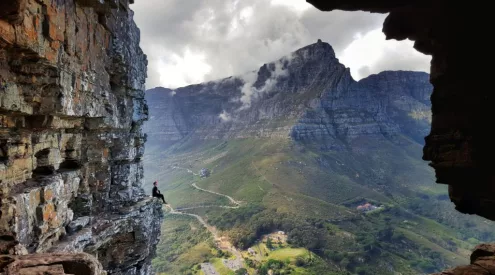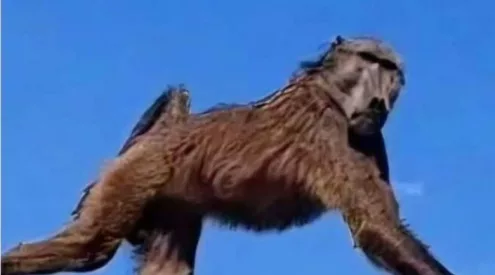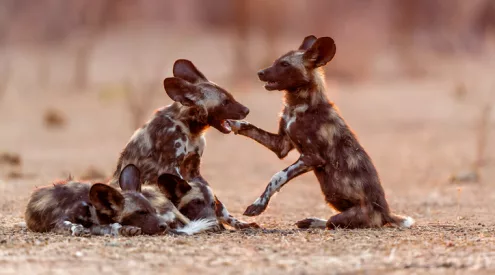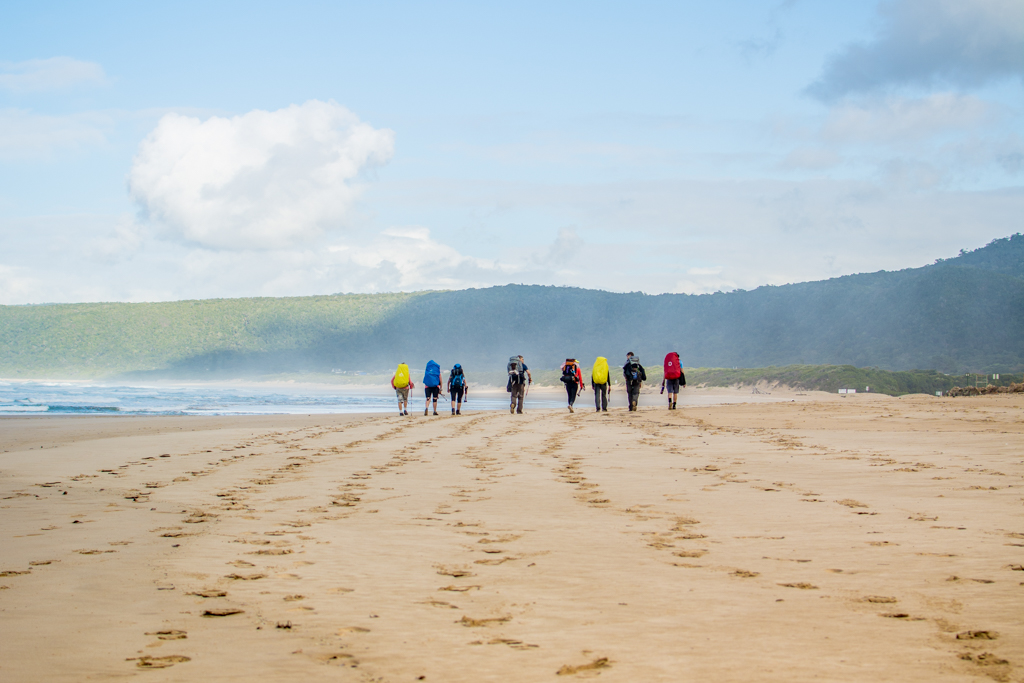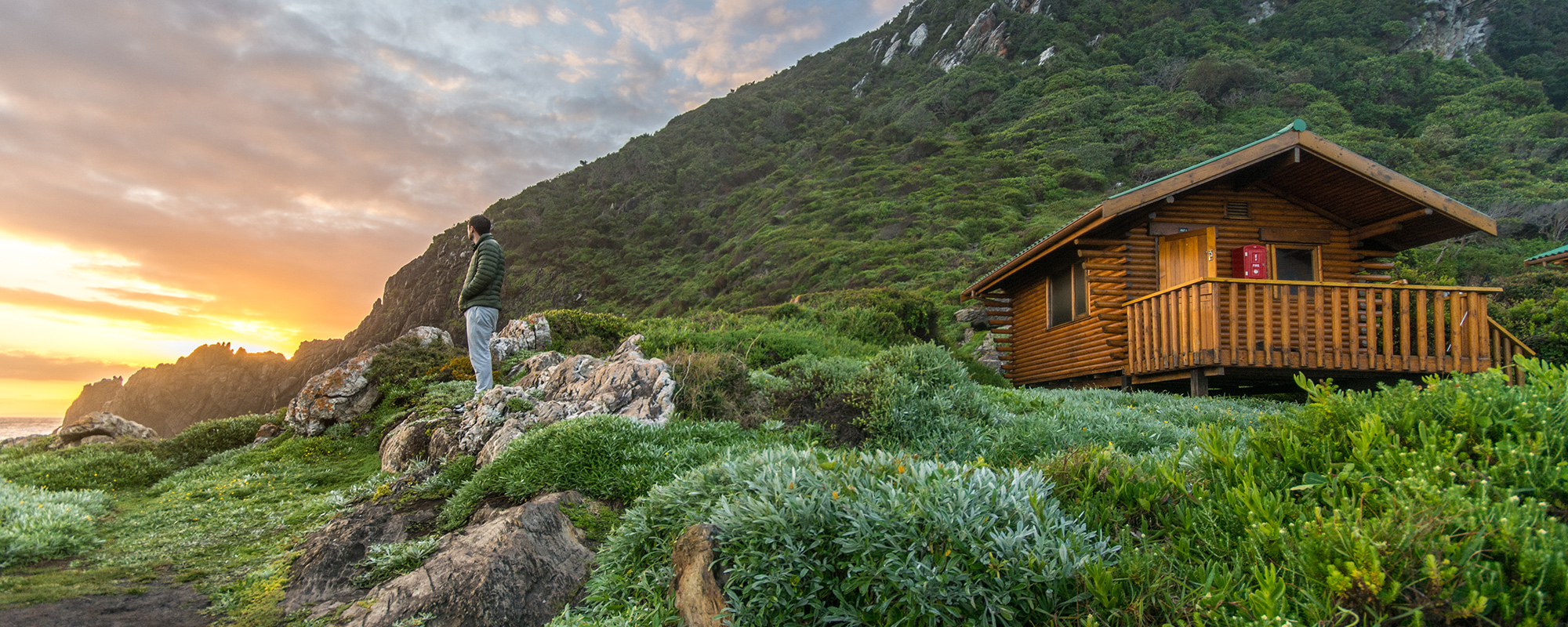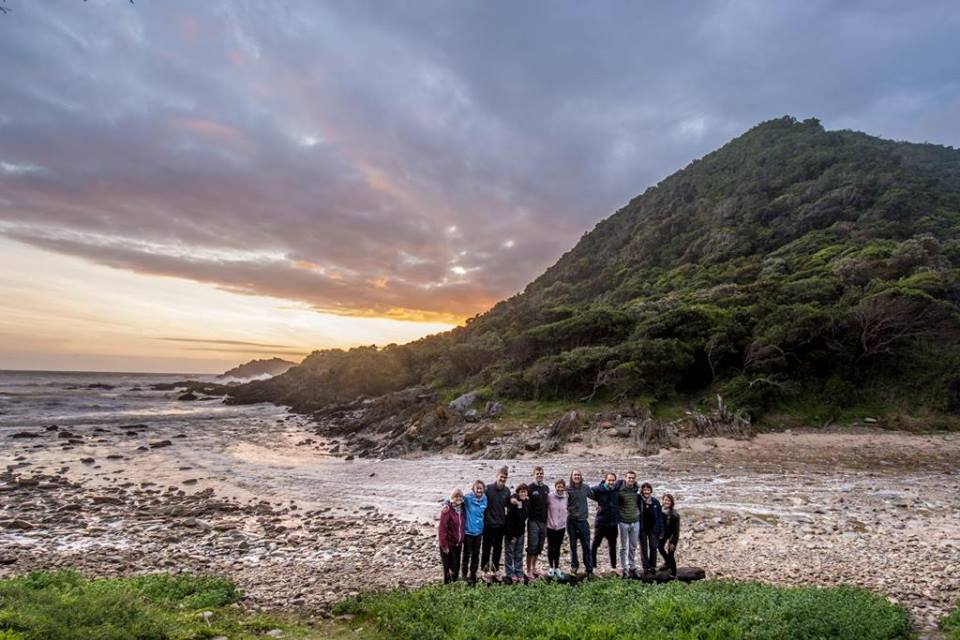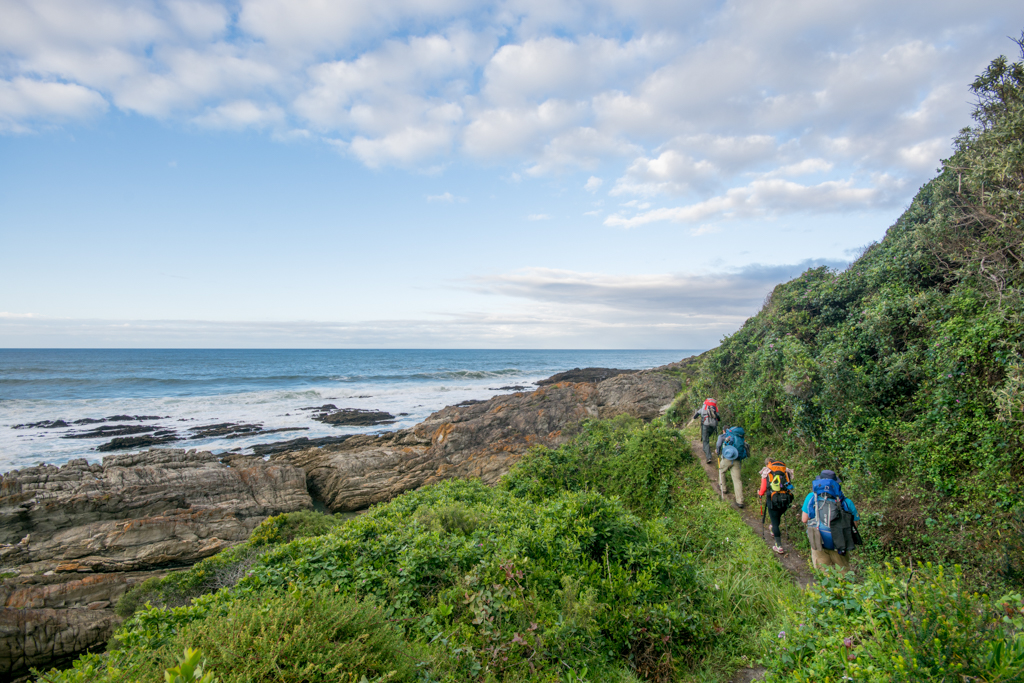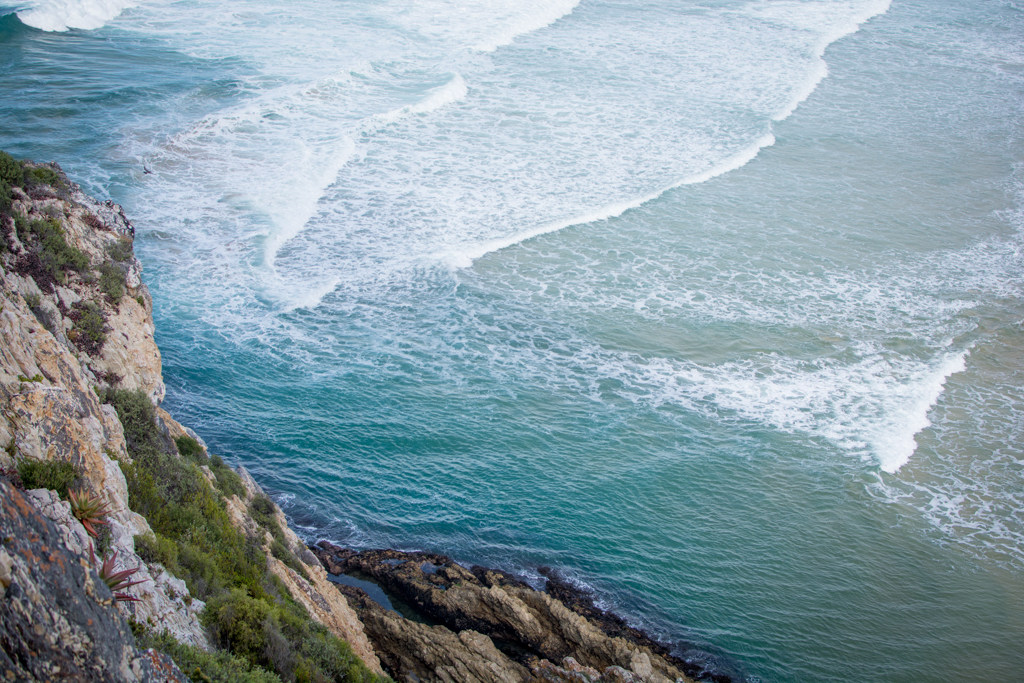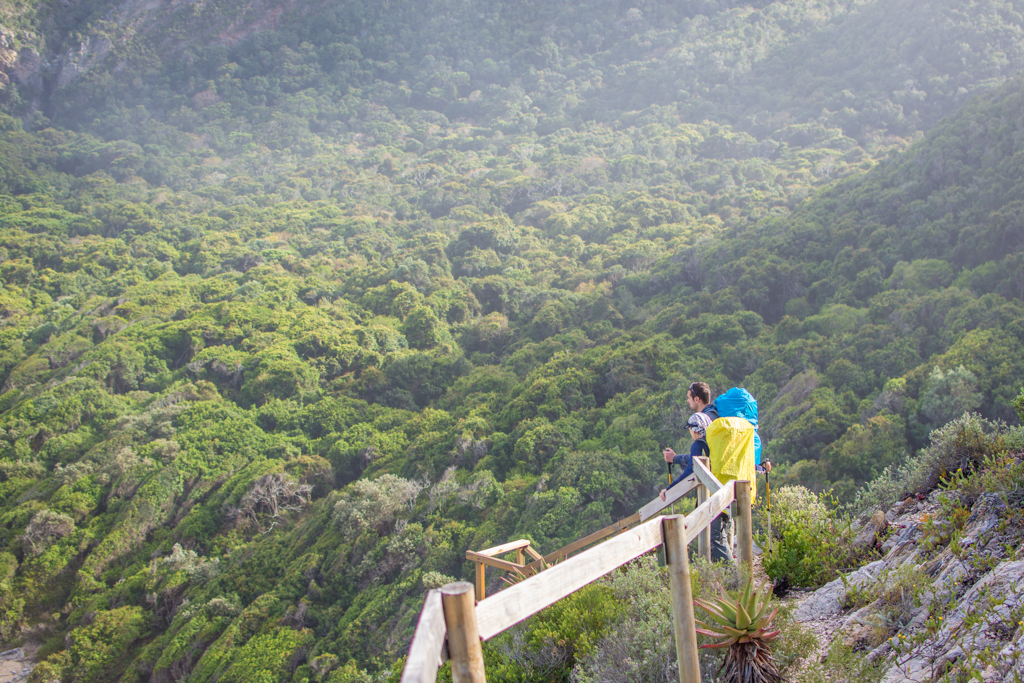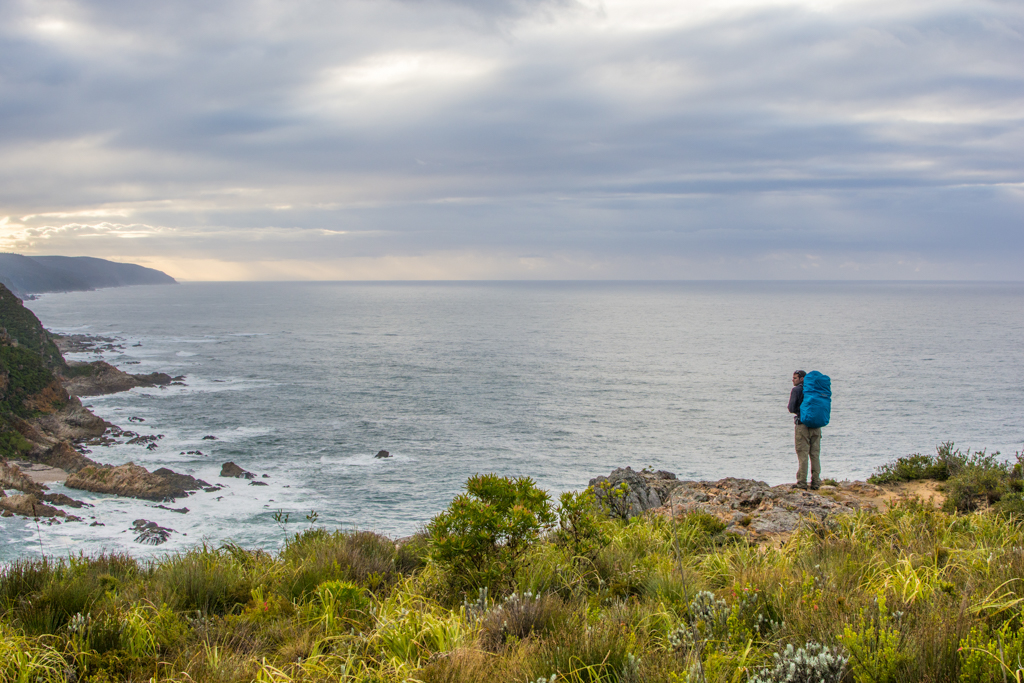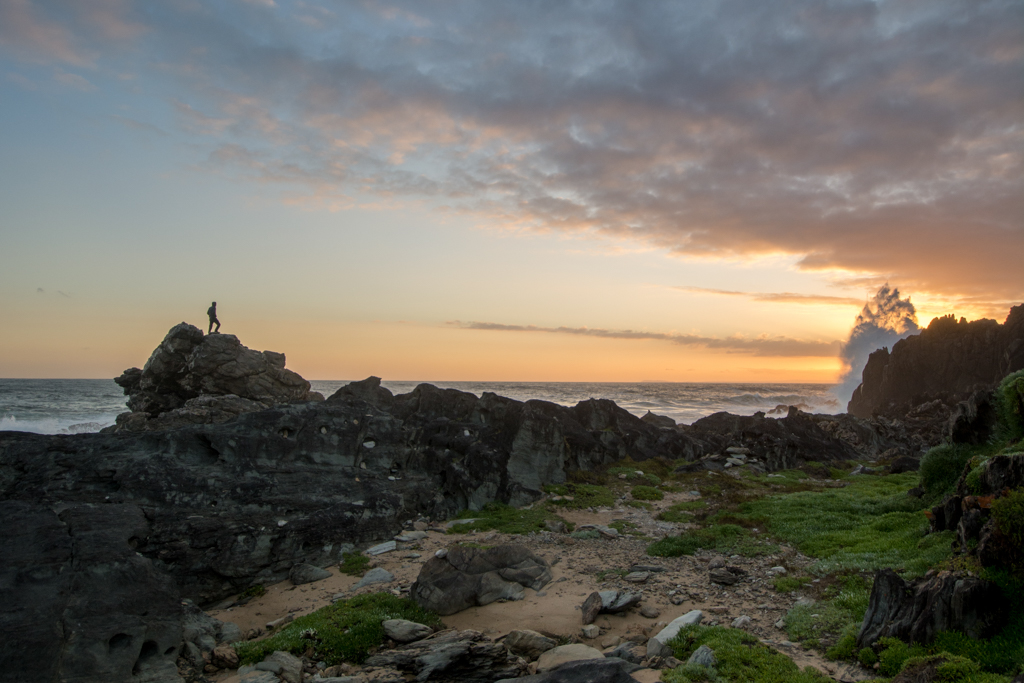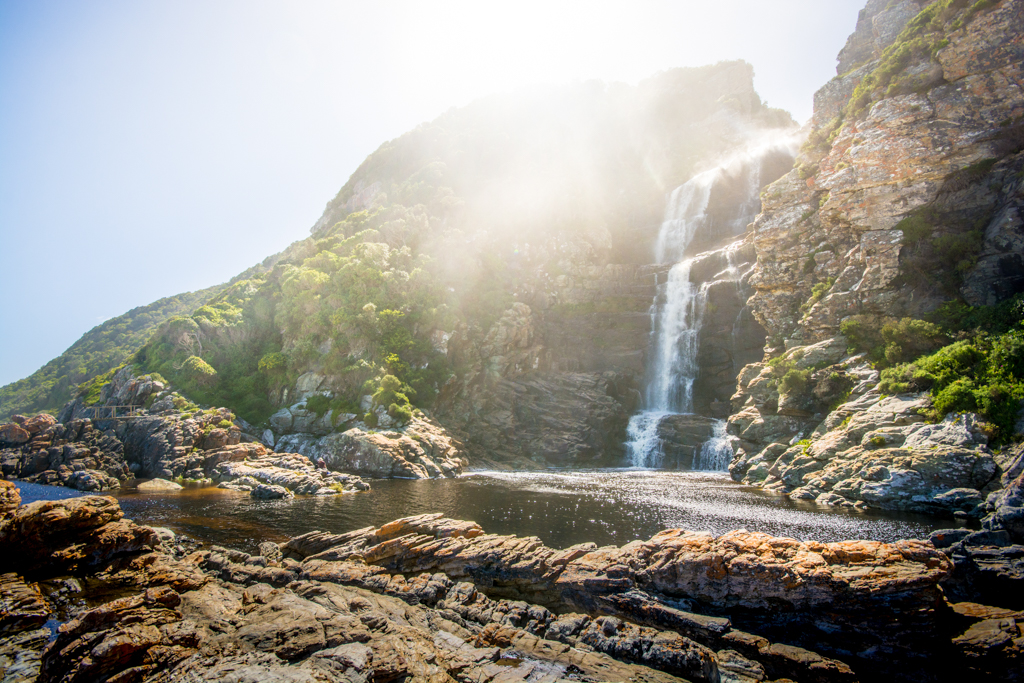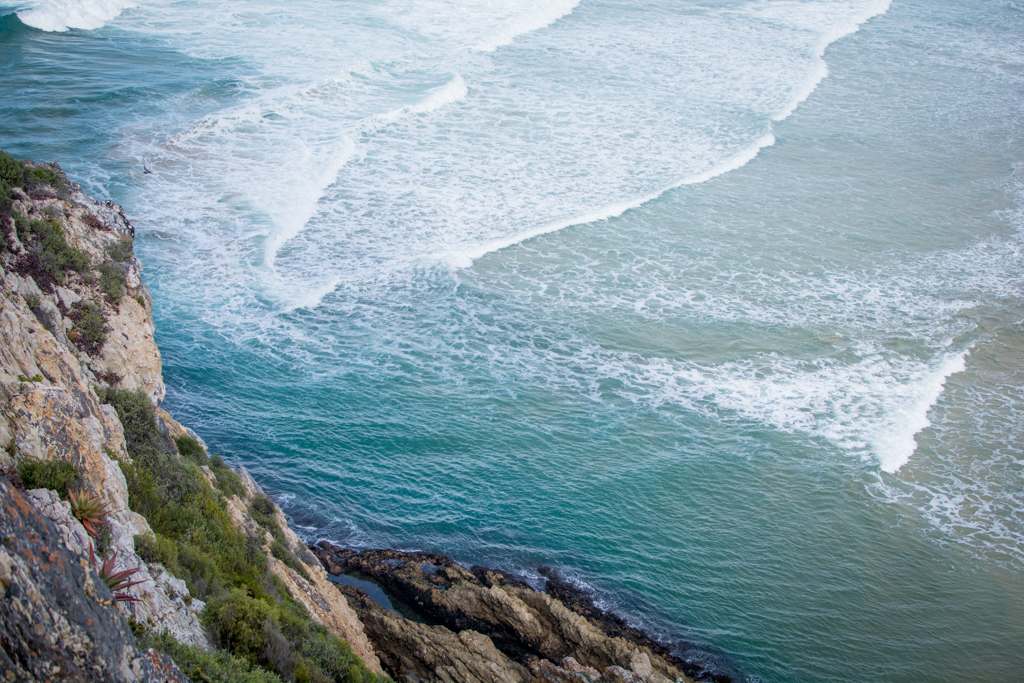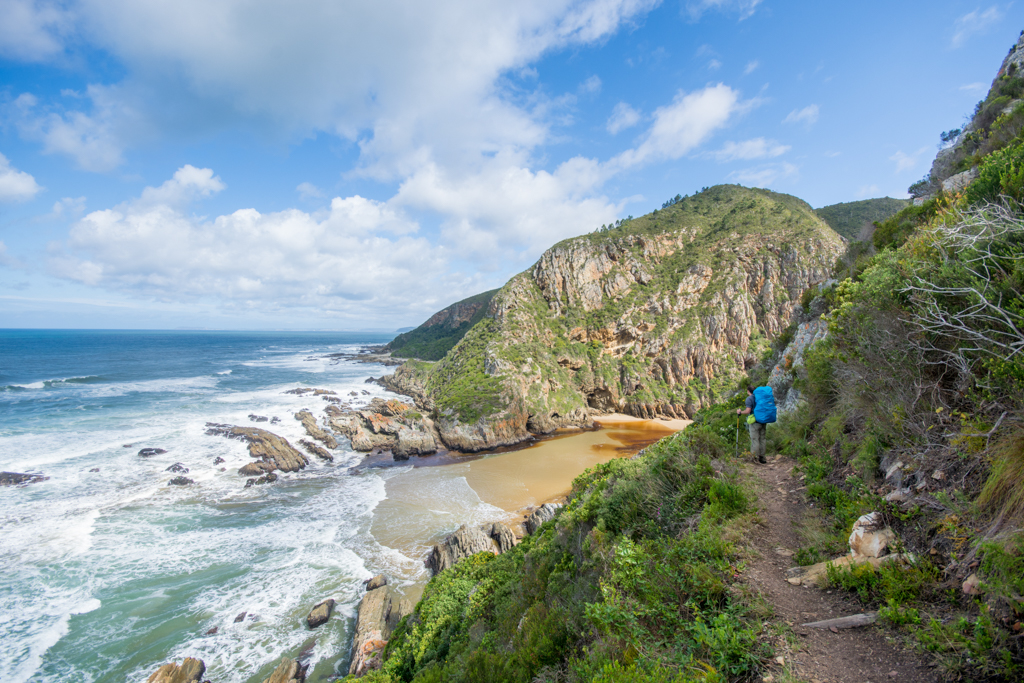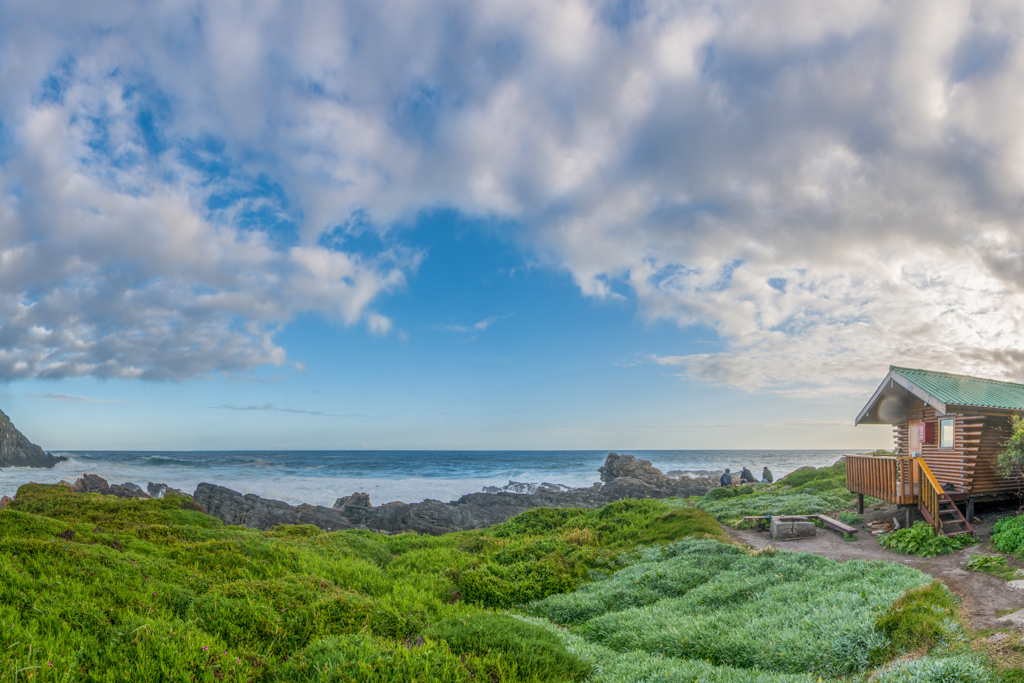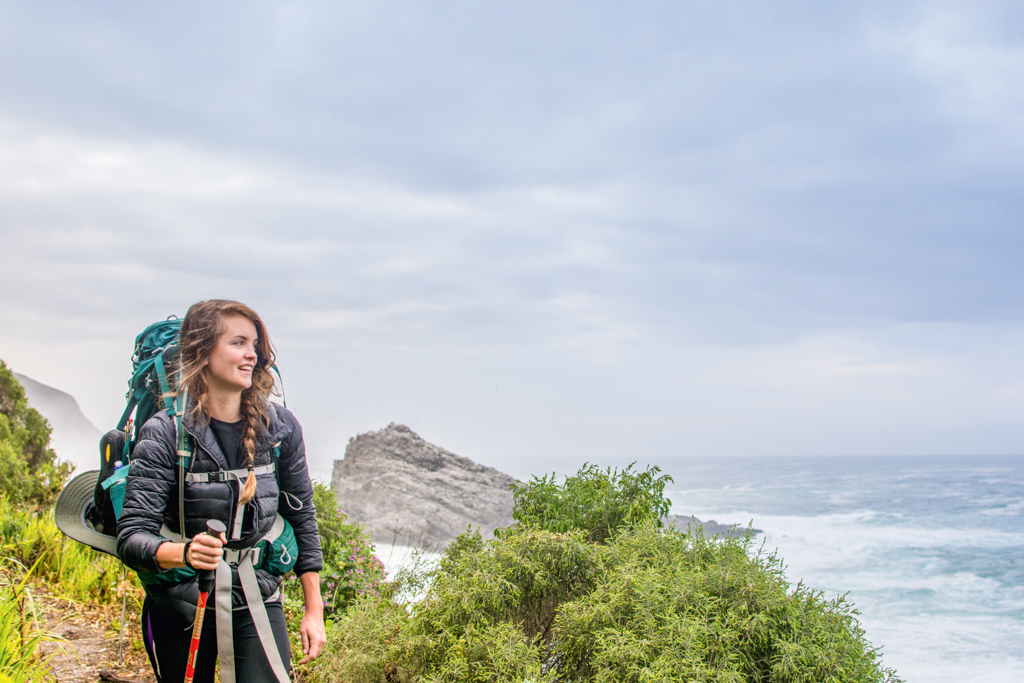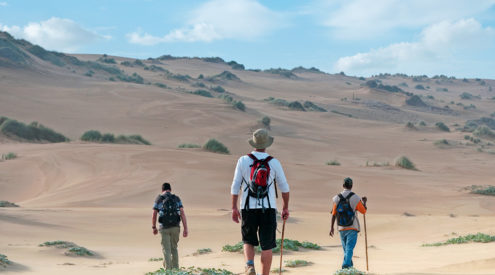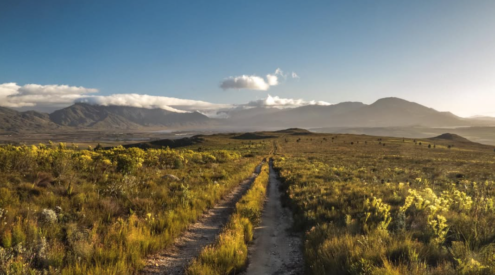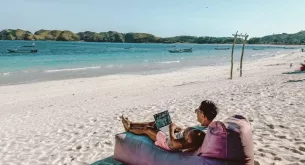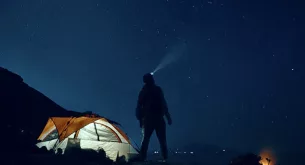This year, the Otter Trail, South Africa’s oldest and most popular hiking trail turns 50. We sent a first-timer, and then got her to interview some folk who have all done it differently.
Read on and choose the way that suits you best
The Otter Trail: Vital Stats
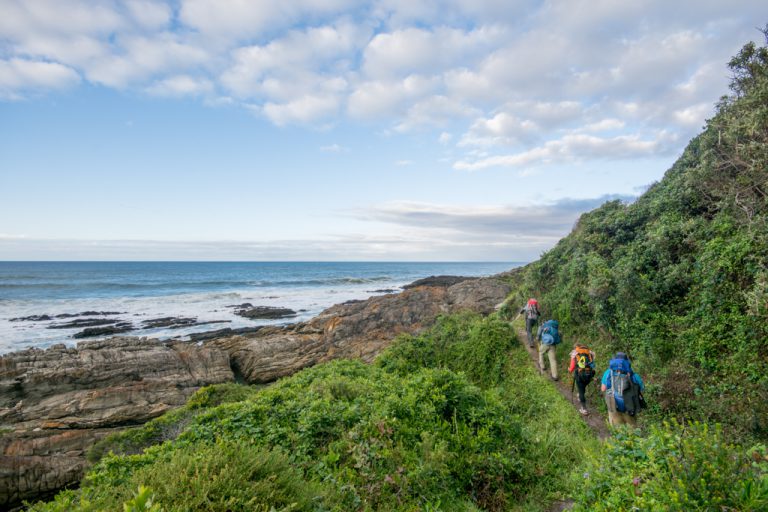
There are many log stairs but there’s always something beautiful to look at from the top.
Opened January 1968
Total distance 45km
Time to complete Five days for hikers and about 10 hours for (normal) runners
Status Green Flag
Accommodation Rustic
Fitness Good technical hiking ability with moderate to good fitness required
The First-Timer: Melanie van Zyl
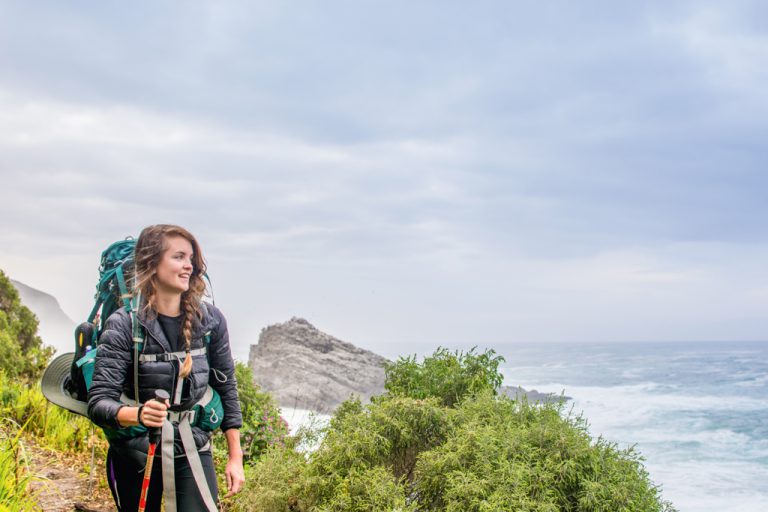
Getaway’s Melanie van Zyl on day three of the Otter Trail.
Age 26
Otters completed 1
Injuries 0 (unless you count hip chafe).
Highlight Spotting a Cape clawless otter.
Lowlight My backpack was too big, which meant I could pack too much.
Going again? In a heartbeat, but not without the advice from the regular hikers/runners listed below.
My team, a motley crew of moms and mates had all packed and unpacked, then repacked again about three times on a drizzly afternoon in Nature’s Valley. Nerves were high – both jitters and excitement. For all but one of us, the next morning would mark the start of our first Otter: 45 kays of quintessential coastline hiking along the shores of the Eastern and Western Cape.
I’d been looking forward to it for months, having begged and bargained my way onto very fit friend Alistair Jackson’s booking. He’d made it a year in advance (to the day, so it included a weekend and public holiday) knowing just he and his mother wanted to hike it. He anticipated little problem filling up the other spots, and he was right. Just 12 people can hike each daily section of the trail and the only time you’re likely to bump into others is on the first day when day-trippers can walk to the beautiful ocean-side waterfall.

Team photograph at sunset on day two of the Otter Trail.
The following morning we gather for a team photo next to a signpost that marks the beginning of the trail above the Tsitsikamma forest – all smiles, clean clothes and big bags. Next to it is the Otter meeting room. Inside, I weigh my backpack on a scale that looks like a meat hook hanging from one of the beams. The needle locks position at 20 kilograms. That’s flippen heavy for a woman my size. Experts recommend carrying no more than a quarter of your weight, making mine six kilos too heavy. Admittedly, I had also packed a papsak of red wine, camera gear to shoot this story and a few fancy foods (sun-dried tomato pesto sachets and biltong spread – luxuries by hiking standards).
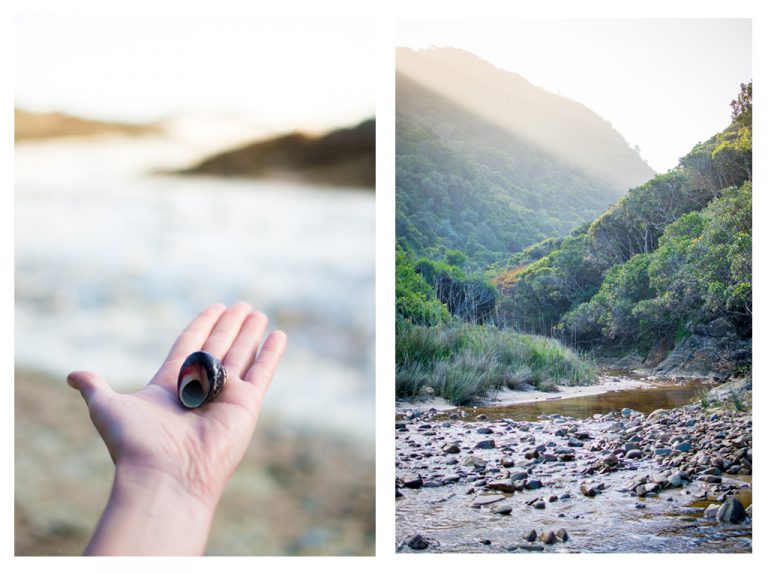
Finding small treasures and rocky gorges at the huts on day 2 of the Otter Trail. Each hut on the trail is based at a lagoon for fresh water.
I properly regret that extra weight on the second day when the uphills and downhills are equally immense. At times, log stairs ascend relentlessly, step after step after step. Apparently, there are 7 000 of them, and those are just the ones going up. The day is tough for everyone, but at the end of it we’re having sundowners around a warm fire beside two beach cottages at the Geelhoutbos River mouth, under a sky dripping with the kind of colours you’d find in a cocktail. Our hearts are full and we feel euphoric. Two oystercatchers even join us. That night I eat more, not because of an appetite but to free up packed weight, and I make sure to put a good dent in that papsak.

Find beautiful Black oystercatchers and fairy-like forest light along the Otter Trail.
It gets easier in the days that follow: my pack lightens, my legs find their strength and special sights keep spirits up. The Bloukrans River crossing is the only other big concern. Steeped in myth and fear, it’s the legend of the Otter Trail. Ultimately, it’s easy for us. An early start means we arrive at low tide, stuff our packs into giant survival bags and carry them awkwardly across the rocky river. The hardest part, actually, is climbing the boulders and crags on the other side. All too quickly, the fifth and last day of the trail meanders to an end on the beautiful Blue Flag beach at Nature’s Valley.
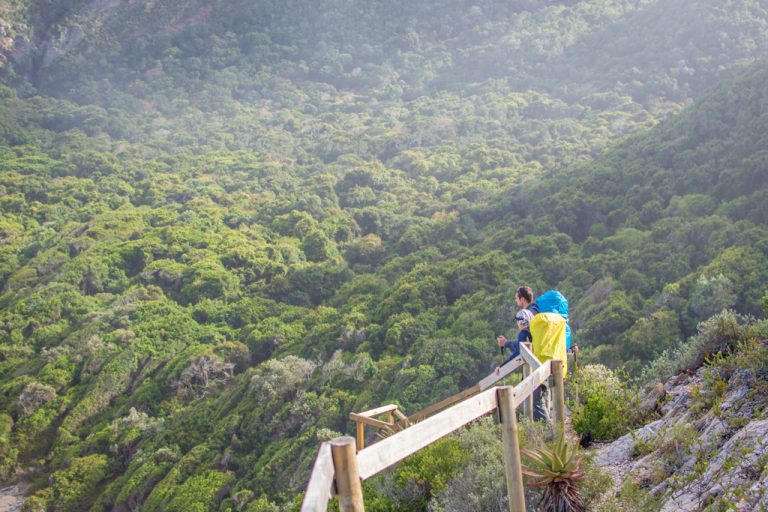
Looking down at the gorgeous blue ocean from a peak before climbing the stairs down to Nature’s Valley.
In five days we’d spotted a lone otter slinking into the ocean from the shores of the rooibos-coloured Elandsbos River, walked through amazing fynbos fields with bright blooms I wish I knew the names of, and delved into damp forests, carefully navigating slippery roots. Although my muscles ached, the beauty and variety of the trail kept us eager to continue exploring this pristine, wild coastline, where a formidable ocean meets the land.
Advice from Melanie’s team
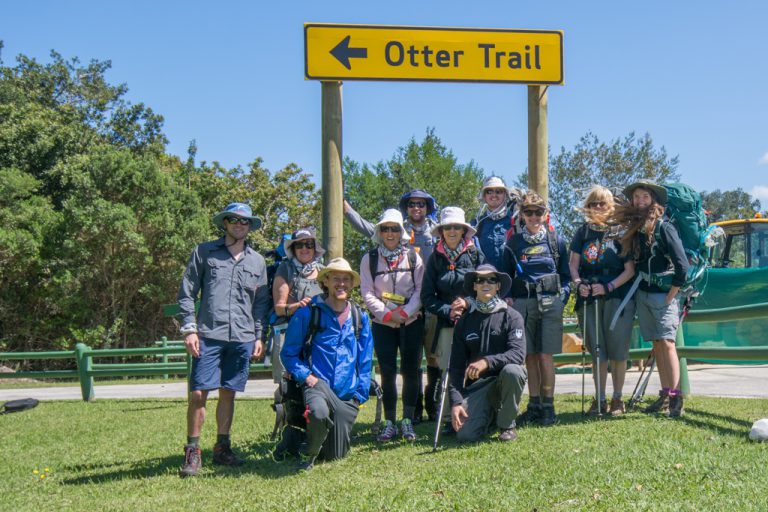
From left to right, Melanie’s team: Scott Bateman, Joan Pickup, Jason Higgins (kneeling), Janet Simpkins, Warrick Haskell, Phillipa Rowney, Alistair Jackson (kneeling), Patrick Jackson, Bridget Bateman, Chloe Smith and the writer.
Janet Simpkins, 34 You need to be fitter than you think. I’m fit, I can walk the distances easily but those first two days were a wake-up call.
Scott Bateman, 28 It’s tougher than the distances lead you to believe – do a bit of training beforehand and pack less clothes than you think you need.
Phillipa Rowney, 61 Use a hydration bladder. It’s easier than trying to retrieve a bottle out of your pack each time you want to drink.
Bridget Bateman, 57 Spend money on decent shoes. I loved my amazingly comfortable Adidas hiking boots. They were like slippers.
Alistair Jackson, 26 Favourite snacks were home-made trail mix, dark chocolate oats bars and small 50ml bottles of Amarula at night.
Also read: Gear I loved using on the Otter Trail
The Runners

A snapshot of the Otter Trail Run (the Retto in 2016)
The Otter African Trail Run Classic takes place every second year at the end of October (every other year the route is run in reverse and called the ‘Retto’). Dubbed ‘the Grail of Trail’ the route is precisely the right distance (42km) to make it a marathon, except one that includes four river crossings, 11 significant climbs and has a Trail Factor of 2,0 – meaning that running this race can take twice as long as the equivalent distance on a road. Here are two athletes who’ve done it
1. Robyn Owen

Robyn Owen on the Otter African Trail Run in 2016
Age 26
Otters Completed 2
Injuries 0
Highlight Running through the flowering fynbos along the top of the high cliffs that drop into the sea.
Lowlight In either direction, the last five to 10 km are the hardest, when I’m already tired.
Best 1st place (2016) in 4 hours and 49 minutes.
‘The trail was even more beautiful and pristine than I had imagined,’ says Robyn. ‘A stretch of coastline that long with so little sign of human presence is very special. You can’t beat the setting: endless views of the rugged coastline, aromatic fynbos combined with sea breeze, and the airy feel created by the massive drop below you’.
‘It was the hardest race of my life. I never thought I could sustain the level of intensity to stay at the pace up front. There are endless ups and downs, so the trail is a lot harder than the relatively short distances sound. Hikers should carry just enough to be comfortable and safe – and wearing slightly smelly clothes is okay! If you’re running, don’t carry more than the mandatory gear. I was thankful for my running shoes but everything else was just extra weight. You can top up on energy at the halfway munchie point – the nougat bars were my favourite snack on the race. However, had I encountered a problem on the route I might have been very grateful for my jacket, warm top, emergency blanket and extra food. I was lucky enough not to need to be grateful for it.

Delicate fynbos and endless sea views from the Otter Trail.
‘My training is probably focused more than I like to admit on my goal to win races, but the reason I do it all is largely as an excuse to spend time outdoors in beautiful wild areas. I’m fascinated by nature and interested in the geology, plants, animals and air movement, and how they interact.’
Will you do it again? ‘Yes. I loved the Otter Run and will definitely do it again – hopefully this year – but I would also love to hike the route over five days to have more time to take it all in.’
Robyn’s tip Include a fair amount of interval training and hill-repeats in your weekly training programme, which should consist of long slow runs, a few shorter hour-long runs, hikes and mountain exploring missions.
2. Thabang Madiba

Thabang Madiba cruising through the water on the Otter African Trail Run.
Age 31
Otters Completed 4
Injuries 0
Highlight Crossing the Bloukrans River… and Nature’s Valley – that’s always awesome!
Lowlight Running over the big boulders just outside Storm Rivers Mouth. It’s hard because you’re already tired when you get there.
Best 2nd place (2014) in 4 hours and 24 minutes.
The up-runs, especially towards the end, always pose a challenge, says Thabang. ‘My racing pack (a Salomon S-LAB Advanced Skin 12 Set) is a lifesaver because I can carry enough food and hydration for the whole race – I’d rather use a bigger pack that’s easy to carry than a small pack that limits me to just the compulsory kit. It’s always best to have the right stuff, especially for trail running. For example: a rain jacket and pants, food, space blanket and enough water. If it starts to rain or your blood sugar level drops or you spend more hours than expected on a trail, that’s when you’re going to need it.
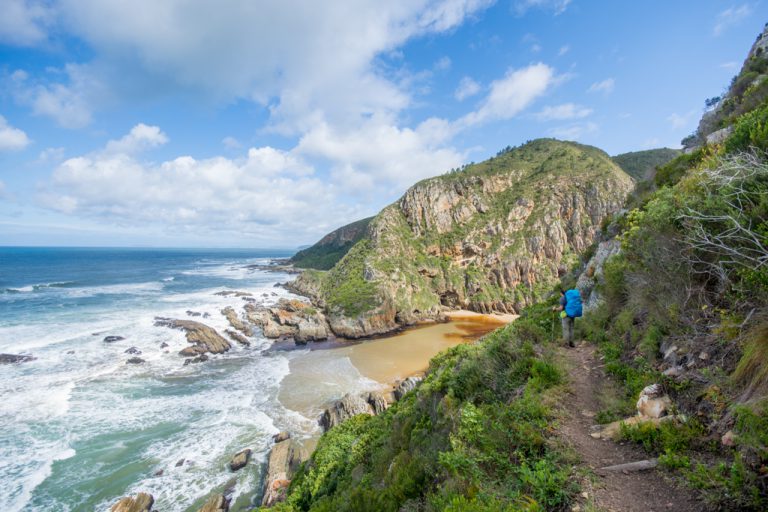
The first look at the dreaded (but beautiful) Bloukrans River crossing on day three of the Otter Trail.
‘In last year’s race I felt sick around the 19-kilometre mark. I was running with Marc Lauenstein and Kane Reilly and was forced to stop. Pulling out was the last resort. I took a 20-minute nap in the second part of the race and walked the last bit.’ [It took him seven hours to complete the course.]
Will you do it again? ‘I will do it again and again until I win it. So far I’ve had two podium finishes. I’m also keen to do the hike with my son some day.’
Also read: Even heroes take naps
The Regulars
I met Henk and Marlene Liebenberg in 2015 when we walked the Tankwa Camino together. Henk audits walking trails, awarding the best with Green Flag Status (the ultimate accolade). Both the Tankwa Camino and the Otter have that status. Fiona McIntosh knows about hiking – she’s authored several books about it. She enjoyed walking the Otter Trail so much she decided to run it too. Here’s why they keep coming back.
1. Henk and Marlene Liebenberg
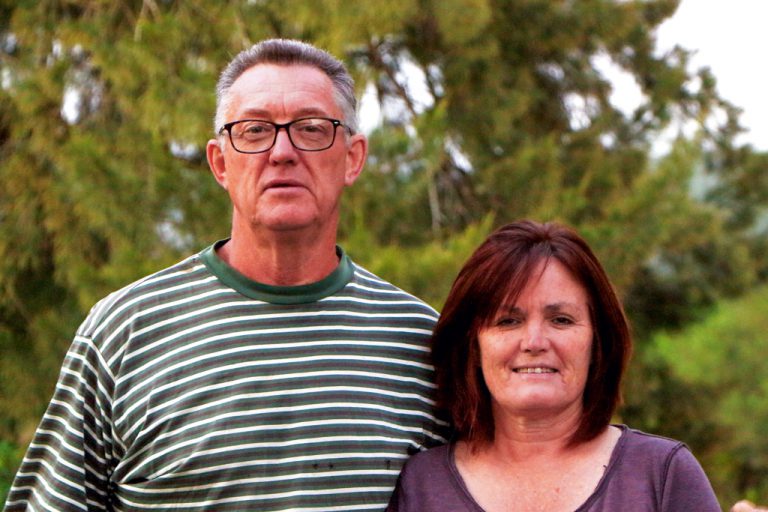
Henk and Marlene Liebenberg.
Age 62 and 60 respectively
Otters Completed 0 (only in sections) and 3 respectively
Highlight The second day – the scenery from the various viewpoints and also Bloubaai, make it the best.
Lowlight Neither of them can think of a single one.
Surprisingly, Henk has never done the full Otter Trail trail in one go, but he regularly walks the shorter daily routes to check up on them and ‘to assess the environmental conditions as well as safety along the trail. Green Flag status ensures sustainable trails in terms of conservation of the environmental resources as well as the quality of experience had by hikers’. In the Tsitsikamma section of the Garden Route National Park, 11 hiking trails have Green Flag status.

Epic views from Oakhurst huts, where you spend the third night on the Otter Trail. Just when you think the locations can’t get better – they do.
Marlene is an honorary Garden Route National Park ranger and nature guide. ‘I hike with trekking poles and always take duct tape, while Henk is responsible for the GPS and camera,’ she says. Marlene also packs sanitary towels which she uses as a cushion for blisters: ‘The best thing I’ve discovered in all my 30 years of hiking!’
Will you do it again? ‘Again and again. There is something of everything a hiker loves.’
2. Fiona McIntosh

Fiona McIntosh sitting at the waterfall on the first leg of the Otter Trail.
Age 56
Otters Completed 3 (two hikes and one run)
Highlight The open stretch along the cliff and down to Nature’s Valley.
Lowlight Watching fellow hikers braai on the first night. I’d packed trail food; they had steaks and roast veg.
‘I can’t start the day without a good coffee,’ says Fiona, so she always packs her Jetboil stove and coffee press. ‘Leave the booze behind (sage advice I wish I’d heard before I packed that papsak!) and go for dehydrated foods such as two-minute noodles. Throw the avouring packs away and use fresh salad/herbs to spice them up. Carry a few luxuries like a tiny plastic bottle of olive oil, tasty nuts and biltong. Take it really slowly and enjoy the moment.’
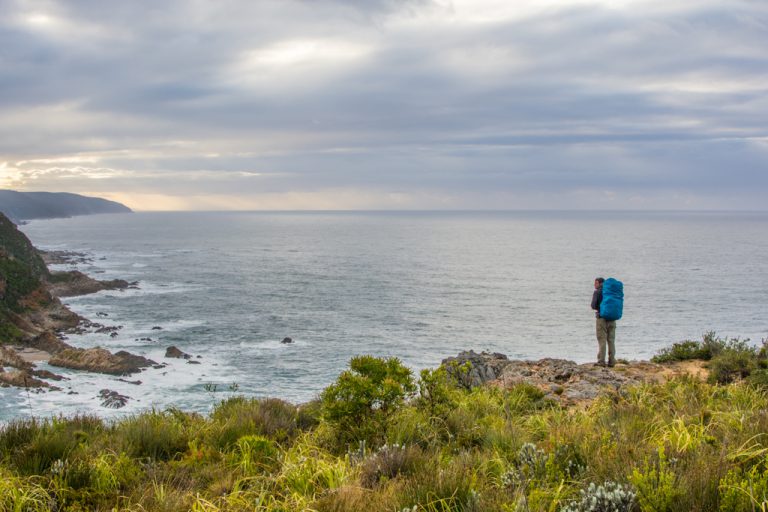
Looking from a fynbos ridge over the ocean. This is the beginning of the open stretch along a cliff before it winds down to Nature’s Valley.
On running it, she says she really didn’t remember the trail as having that many climbs. ‘This has to be the most spectacular trail run in the world, and the organisers had thought of everything to minimise the impact on the natural environment and to make our experience as enjoyable and safe as possible. But it’s certainly not for sissies!’
The biggest difference between the run and the hike, she says, is the fact that you can run the trail with just a small pack, because water is provided and all you need are some bars or snacks. ‘So you can really enjoy skipping over the rocks – much easier without a big pack! If you’re packing for just eight or nine hours, it’s a different ball game.’
Fiona has also had the privilege of meeting the legendary Popo Scott, or ‘Uncle Popo’. He helped in laying out the Otter Trail in 1967, and is still involved in the park.
Will you do it again? ‘The hike? Yes. Tomorrow. The run? Well, my golden rule is don’t do anything twice!’
Getting there
Storms River Mouth is 190km west of Port Elizabeth on the N2. Turn left about 8km after Storms River Bridge.

Best time to go
It depends on which conditions you prefer: December to February tend to be the hottest, May to September the coldest, and it’s most likely to rain the most and hardest in August.
Transfers
We left our cars at De Vasselot Rest Camp in Nature’s Valley and took a transfer back to Storms River Mouth. From R100 per person for eight to 12 passengers. geckotours.co.za
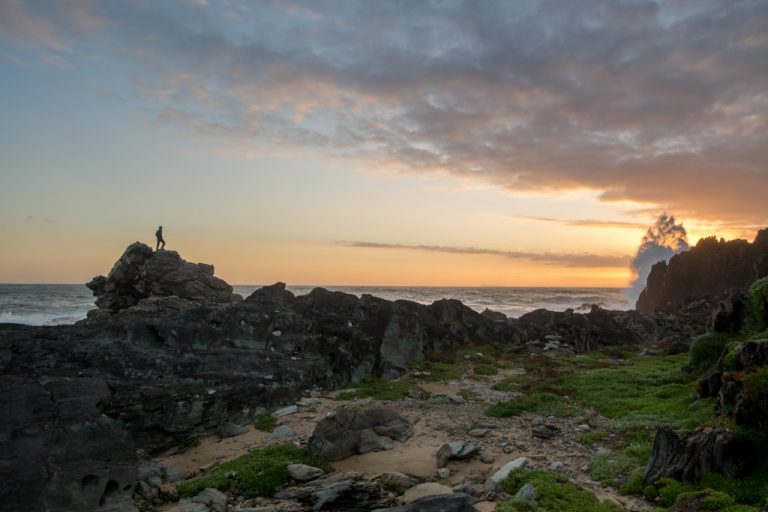
Exploring the rocks and lagoon pools at sunset.
Walk the Otter Trail
The Otter Trail is five days and four nights, from Storms River Mouth to Nature’s Valley. At each overnight camp there are two huts sleeping six each on two triple-bunk beds. There’s a central lapa for cooking or chilling around the fire. Hikers need to bring sleeping bags, cooking equipment and food.
It’s best to get a group of 12 together and book the whole trail, but you can book as a group of six to secure one cabin, and there are also single spots available. It costs R1150 per person, plus a daily conservation fee of R45 (waived if you have a Wild Card). Book well in advance – up to a year – to secure your desired spot. There is no waiting list, but keep checking online for cancellations. sanparks.org
Need to know
There are rain tanks at each camp with drinking water. You’ll be briefed on water usage at the start (pack biodegradable soap), and this includes which rivers and streams you can drink from. Firewood is provided, but it’s not covered and can be wet on arrival, so don’t bank on it. I wouldn’t call the trail extreme but you need to be prepared, fit enough for the uphills and nimble enough to clamber over rocks.
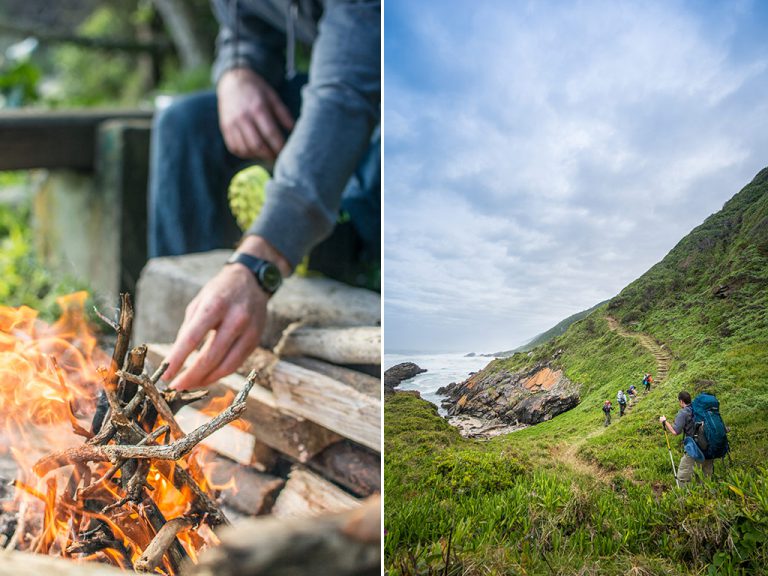
Making a braai at one of the camps along the Otter Trail – because nights are for fires and discussing the day’s walk.
Do this
1. Take a short stroll across the Storm’s River suspension bridge before you start the trail.
2. Stop for lunch at the Jerling River waterfall on Day 1 (this is at the end of the Waterfall Trail walked by day hikers).
3. Have a braai on the first night – it’s a short day and you can afford to carry a little extra.
4. Find the path to Bloubaai Beach on Day 2 (the toughest). We saw the path to it from the lookout at the top of a very long climb but nobody in our group was keen to descend again to find it.
5. Pack food away properly if you plan to leave your backpack anywhere – it will be ransacked by baboons!
6. Look for Cape clawless otters on Day 3 on the far bank of the Elandsbos River – your best chance of a sighting.
7. Make the Bloukrans River crossing easy by checking the tides ahead of time (tides4fishing.com) and pack a headlamp in case you have to make an early start to get there when it’s at its lowest. Buy a waterproof survival bag to seal your backpack. R120, capeunionmart.co.za
8. Take it easy on the final day. This last stretch is beautiful and goes fairly quickly despite the longer distance.

The last stretch to the end of the Otter Trail is an easy trundle along Nature’s Valley beach.
Stay here
For accommodation before and after the trail, Rattrays Cottage in Nature’s Valley is a beautiful self-catering beach house with six rooms, and easily had space for our whole group with four bunk beds to spare. It comes with beach chairs, body boards, umbrellas and paddle skis. From R3000 per day. 0346421843, naturesvalley.fugitivesdrift.com
Run the Otter Trail
Bookings for the Otter African Trail Run Classic 2017 (in October) are full, but there is a waiting list. Keep an eye on the Facebook page to check when entries open for the Retto in 2018. The race has four categories:
The Run covers the full trail and must be completed in under eight hours (R4600).
The Challenge also covers the full trail but is ‘more social’ – it can be completed in under 11 hours (R4300).
The Dassie is a 10km trail race along a section of the route (R220).
The RockRat is a 6km dash (R180). otter.run
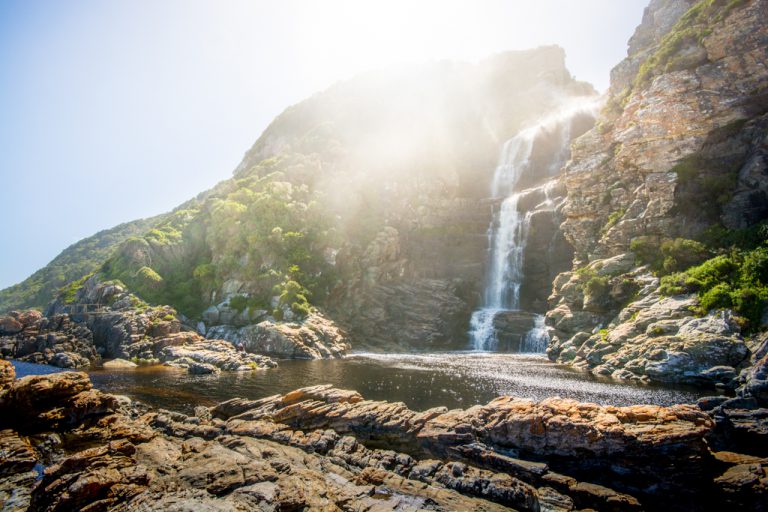
This gorgeous waterfall isn’t just for multi-day hikers. You can do it in a day hike from Storms River Mouth.
Taste the Otter Trail
If you’re in two minds about tackling the full Otter, do the Waterfall Trail – a 6km day hike from Storms River Mouth. It’s an excellent example of the type of terrain on the full trail – rocky shores and forest stairs. It takes roughly three hours to do the round trip, but pack a picnic and you can make a day of it. R45 per person conservation fee. sanparks.org
Also read:
- Can’t get on the Otter Trail? This is Plan B.
- Photoblog: hiking the Otter Trail
- Gear I loved on the Otter Trail
- Five multi-day hiking essentials
This story first appeared in the April 2017 issue of Getaway magazine.
Our April issue features a guide to the Otter Trail, the sunniest roadtrip in SA, and 12 awesome farmstays.


